Snapdragon 800 (MSM8974) Performance Preview: Qualcomm Mobile Development Tablet Tested
by Brian Klug on June 18, 2013 8:00 PM EST3DMark
3DMark for Android features the Ice Storm benchmark and uses OpenGL ES 2.0. Ice Storm is divided into two graphics tests and a physics test. The first graphics test is geometry heavy while the second test is more pixel shader intensive. The physics test, as you might guess, is CPU bound and multithreaded. The overall score takes into account both graphics and physics tests. The benchmark is rendered to an offscreen buffer at 720p/1080p and then scaled up to the native resolution of the device being tested. This is a very similar approach we've seen by game developers to avoid rendering at native resolution on some of the ultra high resolution tablets. The beauty of 3DMark's approach here is the fact that all results are comparable, regardless of a device's native resolution. The downside is we don't get a good idea of how some of the ultra high resolution tablets would behave with these workloads running at their native (> 1080p) resolutions.
For these benchmarks we stuck with the default presets (720p, normal quality).
Here the key comparisons are against the Adreno 320 based HTC One/SGS4 (T-Mobile) and the PowerVR SGX 544MP3 based SGS4 (SHEVE300S). The Nexus 10 is interesting but pretty much a blowout. Snapdragon 800 is clearly the new high-end Android tablet SoC of choice.
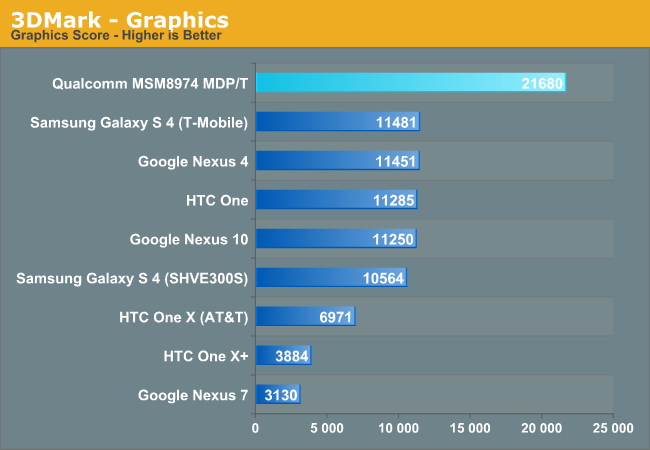
The overall graphics score from Adreno is amazing. We're looking at almost 2x the next fastest contender here, the Adreno 320 based Snapdragon 600.
Graphics Test 1
Ice Storm Graphics test 1 stresses the hardware’s ability to process lots of vertices while keeping the pixel load relatively light. Hardware on this level may have dedicated capacity for separate vertex and pixel processing. Stressing both capacities individually reveals the hardware’s limitations in both aspects.
In an average frame, 530,000 vertices are processed leading to 180,000 triangles rasterized either to the shadow map or to the screen. At the same time, 4.7 million pixels are processed per frame.
Pixel load is kept low by excluding expensive post processing steps, and by not rendering particle effects.

Graphics Test 2
Graphics test 2 stresses the hardware’s ability to process lots of pixels. It tests the ability to read textures, do per pixel computations and write to render targets.
On average, 12.6 million pixels are processed per frame. The additional pixel processing compared to Graphics test 1 comes from including particles and post processing effects such as bloom, streaks and motion blur.
In each frame, an average 75,000 vertices are processed. This number is considerably lower than in Graphics test 1 because shadows are not drawn and the processed geometry has a lower number of polygons.
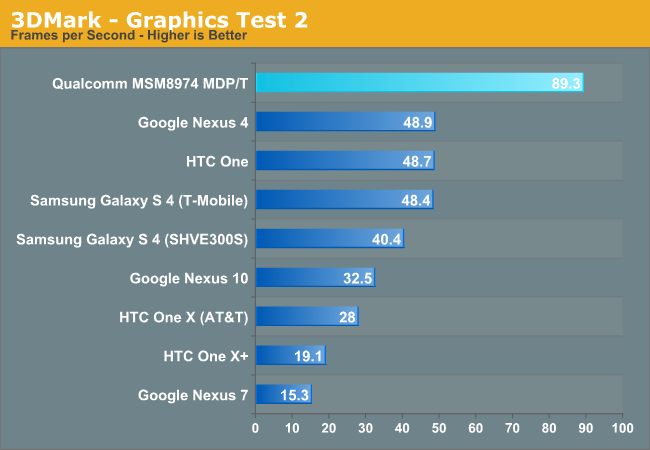
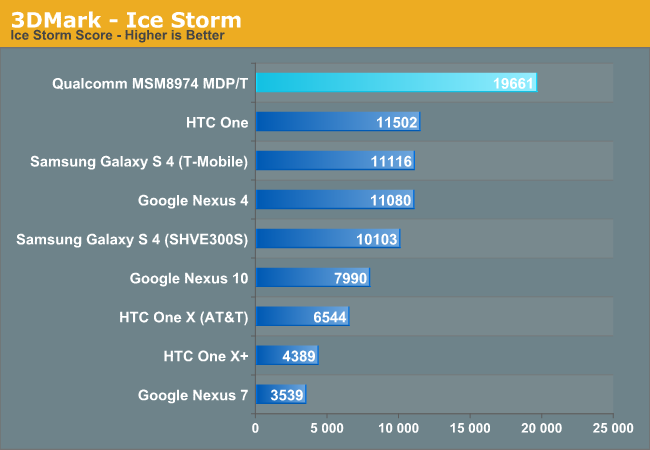
The overall Ice Storm score shows a 71% improvement over Snapdragon 600, which is the closest competitor.
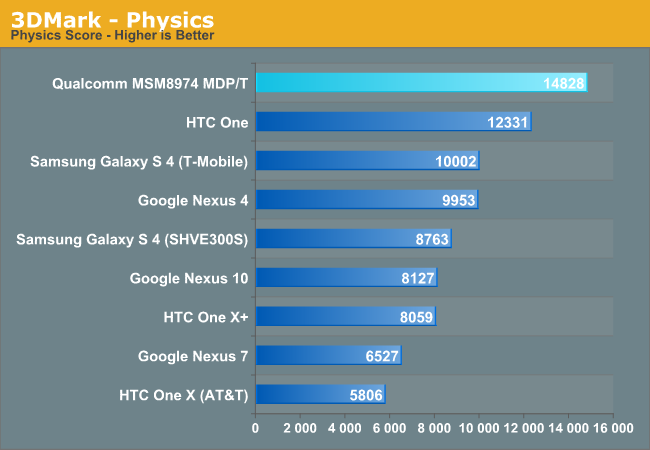
The physics test takes multicore CPU performance into account, but even then the Snapdragon 800 remains ahead of the pack. The performance advantage over the lower clocked Snapdragon 600 shrinks to just 20%, which is a bit lower than clock speeds alone would normally tell us.
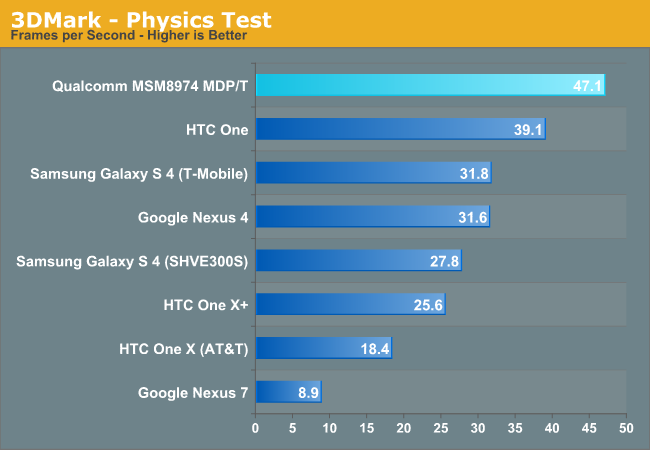










115 Comments
View All Comments
akbisw - Tuesday, June 18, 2013 - link
YESSS!!! THANK YOU QUALCOMM exactly What I expected!!!Piano Man - Tuesday, June 18, 2013 - link
Nice performance, but the lack of power utilization benchmarks prevents me from breaking out the party favors for the time being.clemsyn - Tuesday, June 18, 2013 - link
I agree, power utilization and heat are very important in mobile. Hope this don't come with a fan :)Xilliox - Wednesday, June 19, 2013 - link
I have been working on this for a long time, trust me, it does not need a fan!FwFred - Tuesday, June 18, 2013 - link
Comparing phones to a tablet is a bit odd. Glad there was a Nexus 10 at least.kcsween - Wednesday, June 19, 2013 - link
You all almost sound like this is Qualcomm's first go at making a mobile processor. I'd find it very hard to believe that they'd not take into consideration power consumption and heat or any other negative factors they considered when they made their other chips. Having said that, all that could be out the door in the race bigger and better, who knows. Guess we all will have to wait and see how this things performs in an actual smartphone.arkhamasylum87 - Tuesday, June 18, 2013 - link
How does this compare to the Ivybridge or Haswell Y series processors in terms of CPU/GPU performance? Would like to see those comparisons. So we can extrapolate how this will compare to a fanless Core product from Intel. The gap is there in terms of connectivity but the perf gaps on CPU/GPU would be interesting to note.teiglin - Tuesday, June 18, 2013 - link
Ivy Y no longer seems interesting to me but for the moment, Haswell 15W (both HD4600/5000) would be super interesting to add to the "great equalizer" page of charts. Doesn't Anand have an Acer with i7-4500U as well as the MBA with i5-4250U? Demand he run some benchmarks for you so you can update those charts. The comparison to i5-3317U made sense against APQ8064T, but 8974's contemporary is Haswell, not Ivy.And when you have Haswell Y samples, those would be neat, too. :)
jeffkro - Wednesday, June 19, 2013 - link
15W still requires a fan.sna1970 - Tuesday, July 9, 2013 - link
not really,the Haswell can run from 6 watts up to 15 watts.